Marketing 5.0 explained: applying it to ALL businesses
Marketing 5.0 is yet another classification by the great traditional and digital marketing guru, Philip Kotler.
Despite sounding new, the truth is that the term was coined during the pandemic, back in 2021.
Note: “back in 2021” seems to be an exaggeration, as it has only been 3 years since the book was released.
But the truth is that in marketing everything moves at a very fast pace. 3 years are more than enough to put everything Kotler theorized into practice, and understand whether his newest precepts work or not.
A quick spoiler: they do work, and they work very well. How exactly this happens and how to apply everything that is already working for your company is what you will discover today in this text.
Shall we get started? We have a lot of theoretical things to talk about here in this initial part of the text. And towards the end, let’s turn the tables and start talking about practice.
What is Marketing 5.0 according to Philip Kotler?
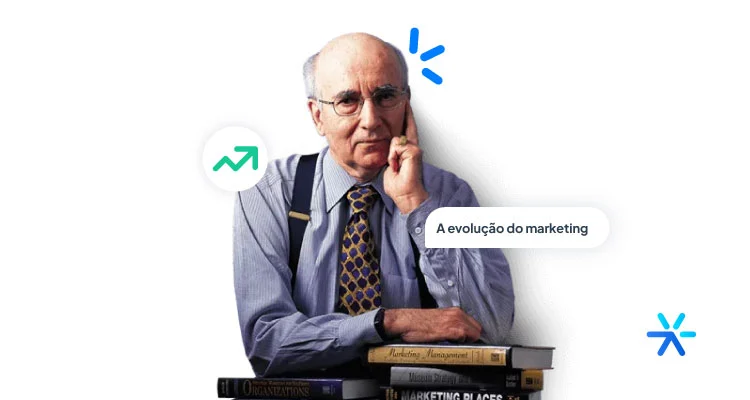
Just to clarify: the term Marketing 5.0 is not only attributed to Philip Kotler, but also to his co-authors — Iwan Setiawan and Hermawan Kartajaya.
The term was described in the book “Marketing 5.0 — Technology for humanity” . See the link to buy on Amazon.
In fact, these two co-authors have worked with Kotler since the launch of Marketing 3.0, which was a huge revolution at the time, being launched in 2010, the year of great popularization of digital marketing.
Marketing 5.0 is the era of marketing determined by Kotler where the integration of technology becomes more urgent.
Not that technology wasn’t necessary before this era. What Kotler postulates in the book is that from now on the integration between marketing, humanity and technology is no longer a differentiator. It’s urgent.
A little more about that. Note that the name of the book is “Technology for humanity”. Here, for the first time in her books, Kotler seeks to go beyond marketing and technology, drawing a direct parallel between humanity’s well-being and what it consumes digitally.
Far beyond placing technology as a necessary tool for marketing, Kotler understands that it is already a central part of everyone’s lives.
Because of this centrality, the time has come for marketing to explore technology in a way that puts its users — our target audience — always first.
The book is a very interesting read as it addresses these themes. Far beyond a cake formula, it seeks to scrutinize the role of marketing in this increasingly connected world.
And also attribute the best practices and tools that Marketing 5.0 has to the success of the brands that apply them.
So, this book ends up being quite fascinating for that reason. Kotler invites us to use technology and place it at the center of our operations and business.
But also thinking about its impacts and how to overcome the challenges that a digital society brings in a way that continues to generate more and more results for companies.
If it’s all seeming a little abstract, don’t worry. Let’s start going into details now, after this synopsis.
Just look:
Better understanding Marketing 5.0 features with examples

Marketing 5.0, as we have seen, invites us to think beyond results and understand the impacts of digital life on real life.
Understanding these impacts and respecting technology users is the great driver of success for brands that apply the Marketing 5.0 concept.
And of course: the integration of brands in this new digital life is even more important. Integration with responsibility is the major theme of Marketing 5.0.
If users expect something to be digital, some brand will offer the service or content digitally. If it’s not yours, it will be your competitor.
Here I have listed the main features of Marketing 5.0 in the search for total integration between consumers and digital marketing. Shall we see it in practice?
Artificial intelligence
Artificial Intelligence is already in practically everything you can imagine.
From the cell phone camera of your customers and leads to the Commercial Intelligence system that you apply in your company, everything comes with a good dose of AI.
Marketing 5.0 asks us to understand the relationship between AI and our consumers, and how our brands should approach the tools.
For example: since AI became popular, several brands have started to carry out promotional actions using this technology.
Take, for example, the Disney Pixar AI trend. It was created organically, by the users themselves, but a brand took advantage of it to put its product in the spotlight: Microsoft.
The computer giant has already integrated AI into its Bing search engine, but so far it hasn’t had much success with it.
One of the most recent updates, from September 2023, integrated DALL-E 3 into the platform, allowing millions of users to create posts.
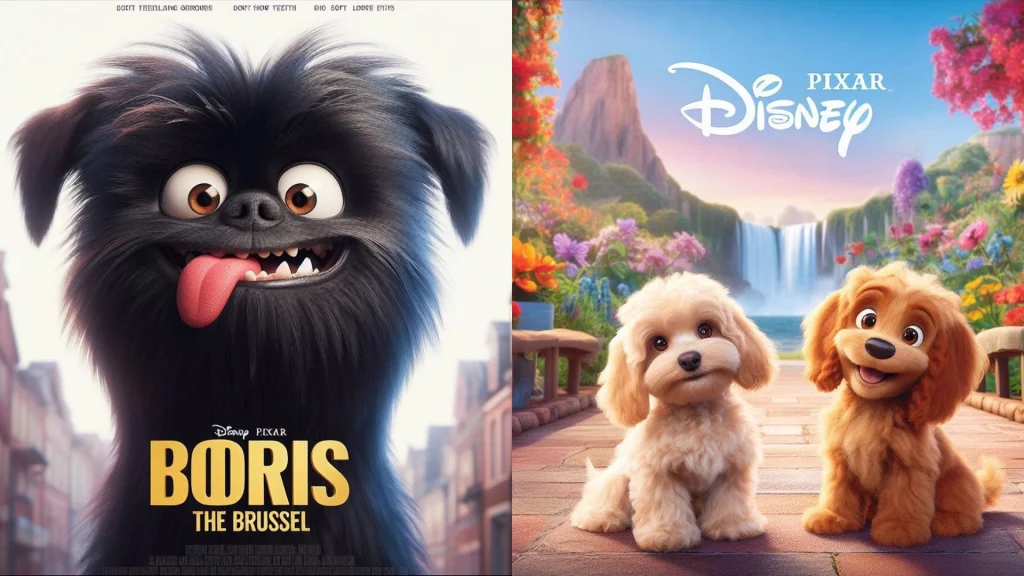
This is the type of resource that Marketing 5.0 requires. The technology was not created by Microsoft, nor was the trend: but with its quick and decisive action, it gained more access and more users to its search engine, which has never been as popular as it is now.
Natural Language Processing
NLP is also a form of Artificial Intelligence, reserved mainly for text generators. In a nutshell, ChatGPT.
Marketing 5.0 invites brands to understand and apply NLP in their actions and marketing routines, but like everything in life, this application comes with some caveats.
Firstly, there is the ethical risk of turning the internet into a huge cluster of texts written by AI. This is of no advantage to anyone!
At the same time, NLP can and should be applied in simpler situations, where a user’s interaction with a brand does not necessarily need to involve a human being.
You will realize how Marketing 5.0 does not walk alone. It’s not just “use this tool”, but also “use this tool responsibly and insert it into the routine of its users”.
There’s no point in creating hundreds of posts and ads with AI if your target audience doesn’t like AI-generated content.
Kotler invites us to think critically, to implement new technologies but always with the user at the center.
Sensors and IoT
IoT even seems like an old topic in marketing, because it has been arriving and arriving and arriving for so long…
But the truth is that it was announced with a lot of fanfare at the beginning of the last decade, and when it arrived, we didn’t even really notice it.
Nowadays, there is already internet in hundreds of electronic devices, from televisions and printers to interactive jukeboxes in bars.
This technology is everywhere, but it is still not being used that well by brands.
Marketing 5.0 invites us to understand it better, seeking to insert it into our marketing routines in a way that always puts user interactions first.
A great example of how this is being done are integrations with Alexa and Google Home. Little by little and with the help of IoT, Amazon and Google are creating true operating systems for the home.
Any product or service that connects to them is masterfully applying Marketing 5.0.
Robotics
Robotics is another resource that Marketing 5.0 invites professionals in the field to use.
However, this is still one of the least developed points here in Brazil and even in the world.
Today, robotics is working mainly in logistics and organization cases, as is the case with Amazon robots.
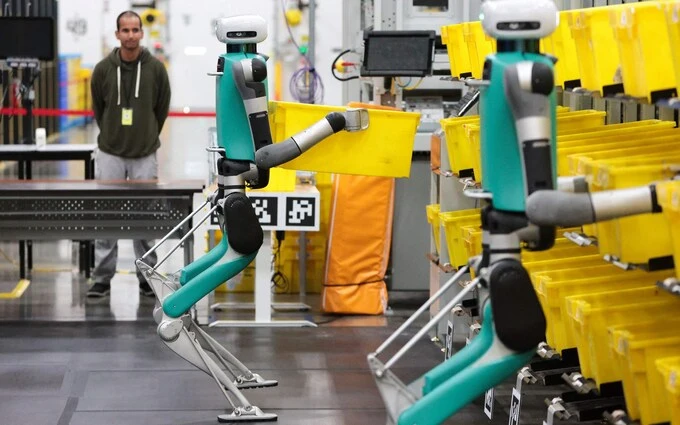
However, the evolution of these technologies has been coming very quickly, and the transformations are right on our doorstep.
Augmented Reality and Virtual Reality
I need to be a little honest with you: in most of the texts you will read on the internet, Augmented Reality and Virtual Reality will always be referred to as “ the metaverse”.
The reality is that the metaverse has failed. The technology came into the spotlight in 2019, driven by Facebook, which soon changed its name to “Meta” precisely to leverage the technology.
And since then, nothing has happened. Facebook itself launched some games and resources, but they gradually fell into oblivion.
The point is that you can’t treat AR and VR as exclusively the Metaverse. As smartphone hardware becomes better, several brands are now able to implement these features in a simpler way.
Guerrilla marketing actions , for example. Or online fitting rooms, measurement apps, furniture stores that place their SKUs digitally in customers’ homes, all of this is already being used today.
Blockchain
The last point, and one of the least discussed today by marketing, is blockchain.
Blockchain is a mix between a ledger and a super computer network. It facilitates digital transactions, operating independently, without the need for bank intervention or government regulation.
Today, the most notable blockchain marketing efforts are NFTs. But there are still those who say, including Kotler himself, that it could completely revolutionize the way we do marketing.
These NFTs, in fact, already represent this possibility. Digital scholars and gurus are already pointing to the possibility of offering NFTs as Lead Magnets , storing users’ information on the blockchain.
This brings more security to users, as this storage is decentralized and the full responsibility of each brand. Nothing is saved on an RD Station server, for example.
And NFTs have the potential to be much more attractive in converting leads, since the model we are used to — e-books, whitepapers, webinars, etc. — is already getting a little dated.
The five components of Marketing 5.0 by Iwan Setiawan
Well, these resources are quite practical, but it’s always good to take a look at the theory too so we don’t get lost in what Marketing 5.0 really offers.
Just one detail before we continue: it is very important that you read the book to understand 100% what it is proposing.
Marketing 5.0 is closely related to the idea of Society 5.0, an initiative by the Japanese government for the future of humanity.
Basically, Society 5.0 advocates for “a society with humans at the center, which seeks to resolve economic and social problems through a system that integrates digital space with physical space”.
It’s almost like saying “what would marketing be like in Society 5.0?”. The answer to these questions lies in the components of Marketing 5.0.
In 2020, Iwan Setiawan, co-author of the book, participated in a webinar that discussed each of these components. You can access the transcript here or read our summary below:

Data-driven marketing
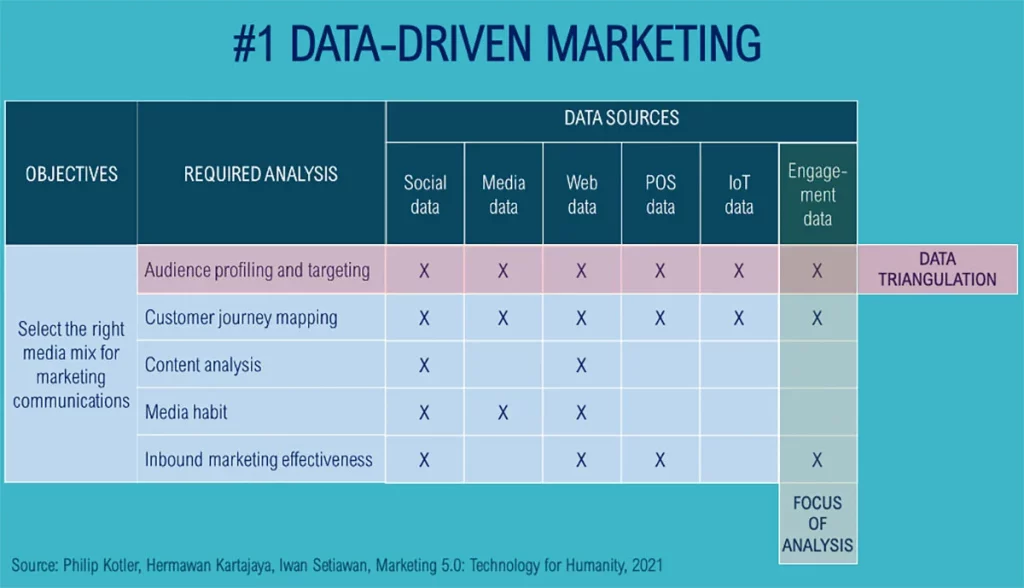
Big Data platforms have been changing the marketing game for some time now.
We have some limitations today that we didn’t have a few years ago — the LGPD, for example, and the end of third-party cookies — but even so, we’ve never had so many possibilities to capture behavioral data from our visitors, leads and customers.
What Marketing 5.0 brings — not only the philosophy, but the book itself — is the organization of this data into large categories, and the determination of points to be analyzed within these categories.
The main categories determined by Kotler, Setiawan and Kartajaya are:
- Social data: interactions and interests of users on social networks;
- Media data: user interactions in integrated advertising campaigns;
- Web data: all types of user interactions on the internet;
- Store data: customer interaction in physical stores;
- IoT data: interaction on devices with the Internet of Things (smartphones, TVs, Alexas, etc.)
- Engagement data: culmination of all this data to build the customer profile and approach;
These general categories bring a large amount of data, which can be captured directly on the source platform and needs to be organized within Commercial Intelligence and Big Data platforms.
It is possible to carry out different analyzes of this data, as long as you work with good tools and have diverse frameworks to analyze it.
For example: a framework could be “inbound marketing effectiveness”. At this point, the most analyzed data categories will be web data, store data and social data.
“Big data” is a scarier phrase than the practice actually is. This data is already being captured. It’s up to you what to do with them.
Predictive marketing
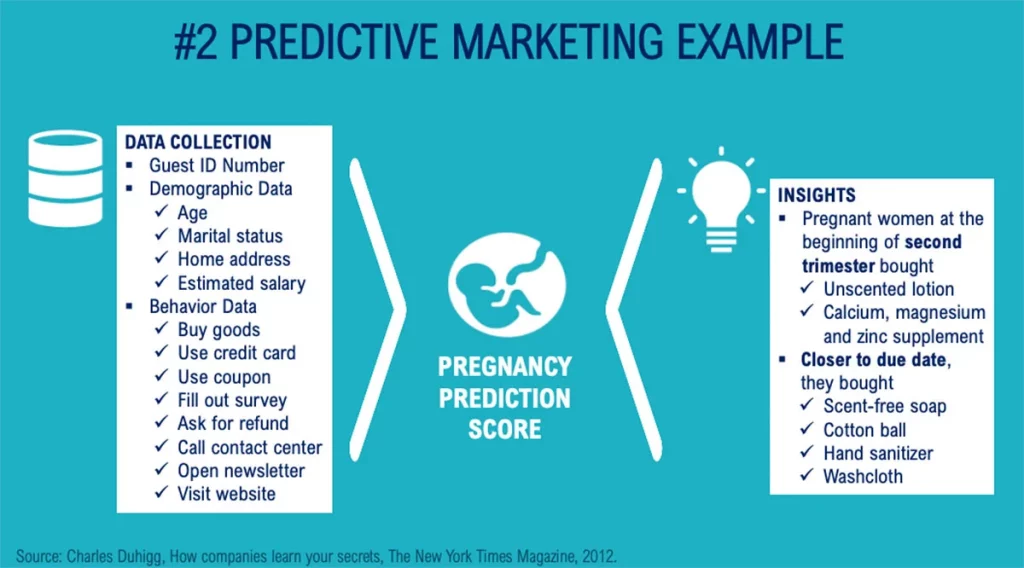
There are already systems in operation today, mainly in large companies, that can predict very important phases of your life.
The Target case is the most famous, and it even appeared in the NY Times in 2012. Basically, based on a girl’s search history on the site, its algorithm discovered that she was pregnant before her own family.
With all this data in hand, it is very clear how your organization will naturally result in predictive marketing.
If you checked all the boxes in the previous topic — that is, collect general browsing data, interactions on social networks, purchases via IoT, etc. — it is possible to say with a good chance of success what your customer will buy.
Even before he himself knew.
Nowadays, predictive marketing is experiencing its golden age with Artificial Intelligence. It is possible to find, with a single Google, dozens of startups aggregating data and delivering predictive reports.
Other large CRM companies — Salesforce is a great example of this — have been investing heavily in this modality as well. It’s a matter of time before predictive marketing stops being a trend and becomes a market standard.
Contextual marketing
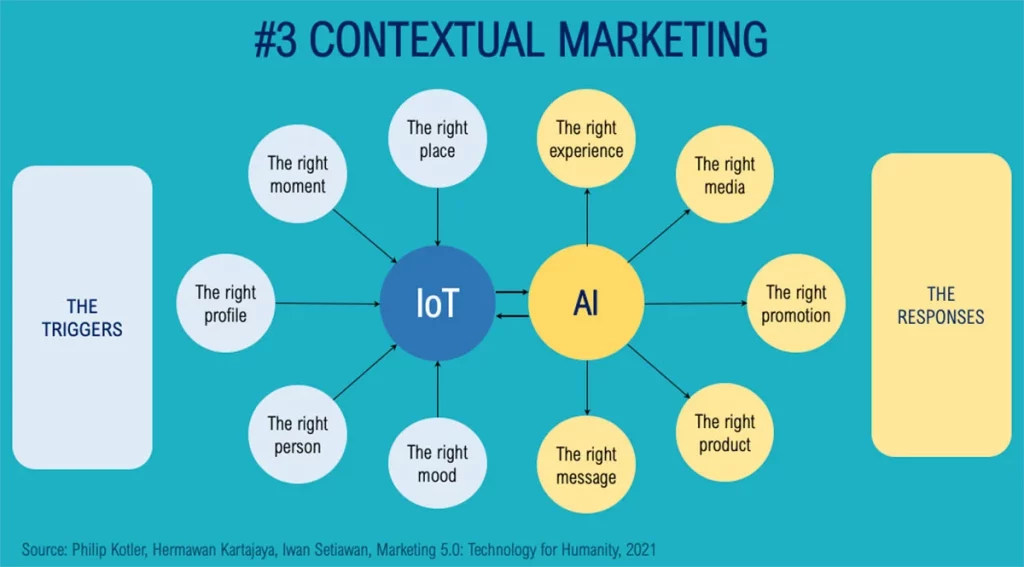
Contextualization is the challenge we are facing now.
As you can see in the last two items, Marketing 5.0 is already quite advanced. It is now fully possible to apply data-driven marketing and predictive marketing.
Contextual marketing can also be applied today and is being applied, but it has been developing little by little, one technology at a time.
There are already companies that use AI to analyze the voice of customers during support calls, and based on their mood, they offer or do not offer other products.
If the person is angry, for example, the AI determines that it is better to just solve the problem. But if she is calm and calm, it is possible to try an upsell .
Augmented Marketing
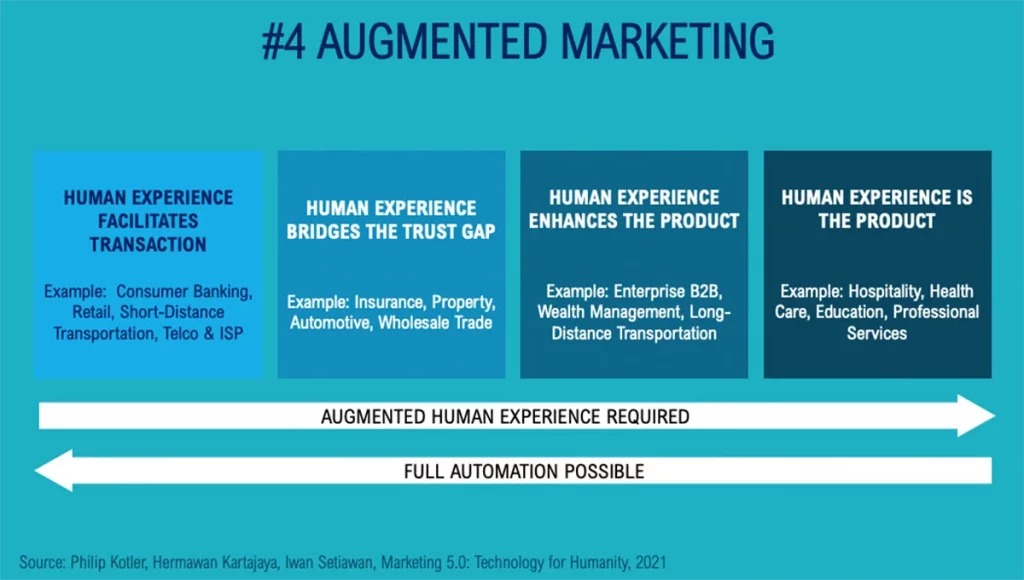
Marketing 5.0 also determines ways in which marketing can improve, or “augment,” its customers’ experience through technology.
Take a classic example: AirBnB. Before him, many Brazilian cities were absolutely exclusive, rare jewels that only those who already knew them were able to visit in high seasons due to the unavailability of hotels in the region.
A tiny town, with just one hotel, holds a winter festival. Tourists can even go, but their stay is limited by the number of free rooms.
With AirBnB, all of that has completely changed. You can even use the app to discover places you’ve never heard of before.
In this graph above, pkmarketing determined, as Kotler defined, a simple matrix for automating these efforts.
Customer experience with the brand goes through four main categories:
- Human experience facilitating the transaction: banks, retail, etc.;
- Human experience increases reliability: insurance, real estate, etc.;
- Experience improves the product: delivery, travel, B2B sales;
- The experience is the product: hospitality, food, etc.;
All of these categories can be “augmented” by Marketing 5.0, and the first two, where the human experience is not necessarily the focus, can be completely automated.
Agile Marketing
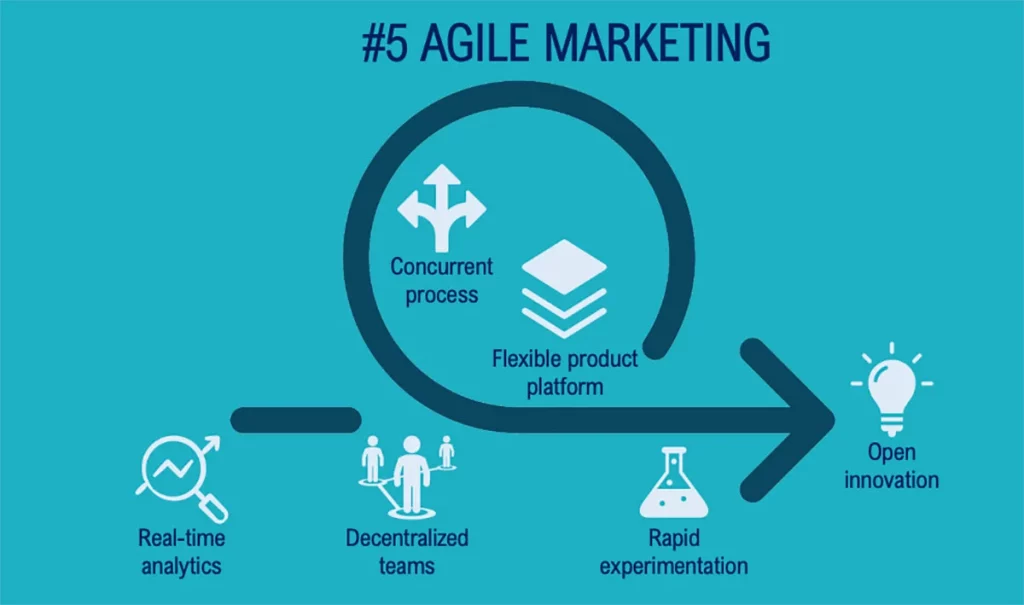
Agile Marketing seeks to implement Agile Methods for marketing operations.
This is not exactly a specific technology or tool that you can buy and implement.
In fact, what Marketing 5.0 asks of us is the end of sequential processes, and the beginning of simultaneous processes.
This is how most technology companies function and operate today.
Agile Methods seek to separate the team into decentralized squads , which develop hypotheses and products and carry out rapid tests through data analysis and production through sprints.
All of this culminates in greater ease in innovating, and ends up generating great results.
Comparison between Marketing 5.0 and previous ones
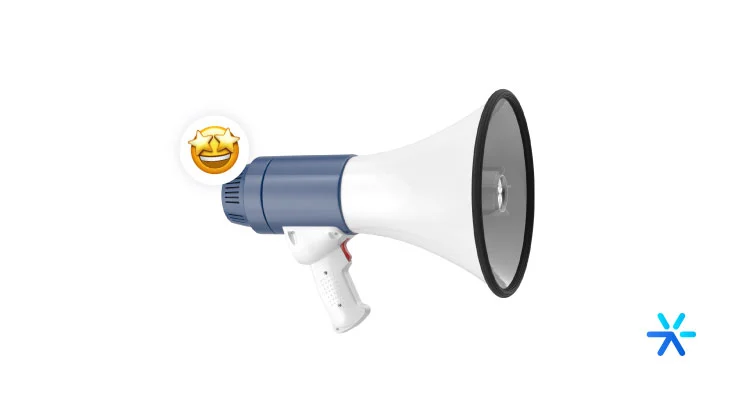
Well, we’ve talked a lot about the theory and practice of Marketing 5.0 so far, right?
But we need to talk a little more about how this classification got to where we are right now.
That’s because, right away, we’re going to talk about the types of business and how they can implement Marketing 5.0 starting today.
Small businesses, for example, still use several resources from previous phases of marketing and are successful with them.
It’s not fair to ask them to abandon everything they’re doing and jump into Marketing 5.0.
So, let’s have this quick moment of theory here just so you understand what resources you are using from the different phases of marketing.
And ultimately understand which ones can be used in your Marketing 5.0 strategy.
Let’s go?
Marketing 1.0
This is the “product” phase of marketing. The quality of a brand was primarily associated with the quality of the products it was able to deliver.
Marketing 1.0 strategies revolved around getting the product in front of the consumer, no matter what the cost.
In his book “Scientific Advertising”, Claude Hopkins details some of these processes, many of which began at the turn of the 14th to the 20th century.
One of them you should see being used to this day: the free sample. Hopkins paid the retailer directly for the price of a box of his product. Then, he offered coupons to his target audience.
These coupons are worth the product, which was taken directly from the retailer. Because Hopkins was confident in the product being sold, he had no reservations about offering it for free. In fact, he knew this was the best way to get loyal customers.
All this changed, however, as human industrial production grew after the two world wars. Marketing 2.0 has come to dominate the world:
Marketing 2.0
Competition became enormous after the war. Japan, after its reconstruction, became a major producer of electronics. Post-Mao China went from being a rural country to a true titan of industry.
And the USA itself, with the accelerated growth of the population (the famous Baby Boom of the 40s and 50s), also started to have hundreds of very similar products fighting for space in the market.
This was the end of the product era, and the beginning of the consumer era. Before, you could go into a grocery store and choose between two brands of your choice — and generally, one was more expensive than the other.
Now every market has dozens of brands. How to stand out?
Simple: focusing on the consumer. All advertising efforts stopped focusing so much on the qualities of the products, and started illustrating how that product was right for that demographic.
Focus on the word demographics. She’s going to be important soon.
Products started to become different, mainly in terms of prices. Then, they began to have specific regionalizations. And all of this being communicated incessantly by marketing.
However, it is quite clear how this movement had an expiration date, isn’t it? It’s just a way of sweeping the competition under the rug.
The only way to deal with the competition was — and still is — through personalization in marketing . And then marketing 3.0 came along:
Marketing 3.0
Marketing 3.0 was born with the need to stand out from the competition, to connect with people on an individual level.
Here, we are no longer talking about what is the right product for each demographic, but rather how to deliver the right product to a specific type of person.
For the first time in the history of marketing, we began to think about the individuality of each human being. What moves each person, not what is best for each segment of people.
This was the golden age of advertising. Copywriting was invented. Large Madison Avenue agencies took over the world at that time, with several of them still active today — in Brazil, we have Ogilvy and BBDO, for example.
Marketing 4.0
Right now, we are transitioning between marketing 4.0 and 5.0.
With the internet, a lot has changed. A lot indeed. Marketing mainly. We are already absolutely individualized, even more so with the advent of methodologies such as Inbound Marketing and Content Marketing .
Now, we seek to deliver value to each individual within our target audience. And there’s something completely different from all the types of marketing that have come before: in some cases, the product barely exists.
In lead generation, you can spend an entire week in contact with a visitor and, in every point of interaction they read, have no mention of the product.
Marketing 4.0 also brings a great emphasis on data generation and interpretation. Something that was taken advantage of and expanded in Marketing 5.0.
Now, to finish, we need to go even deeper into practice and understand how companies of different sizes can apply Marketing 5.0. Come with me?
How to start doing Marketing 5.0 as an SME?
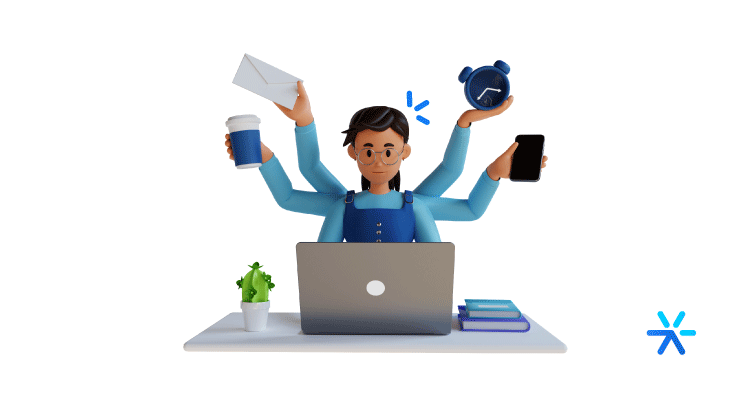
Starting to do Marketing 5.0 is not a very difficult job, actually.
It’s just a matter of changing priorities and approaches. One of the techniques we discussed throughout the text, Agile Marketing, does not even require specific technologies.
The point is that fully applying Marketing 5.0 is still not a very easy task for all companies, largely due to the limitations of technology.
For example: using Natural Language Processing to serve customers via chatbot is a reality, but the technology is not yet where we would like it to be.
So, everyone needs to work within the limitations that time and the balance of progress impose on us.
The difference between small, medium and large companies is how far they can go in Marketing 5.0.
I created a quick diagram here that will help you understand what the most common limitations of these company sizes are, and what you can do in your business today to take your first steps in Marketing 5.0.
Marketing 5.0 for small businesses
Small businesses can start small, with some technologies that are already available and are very simple to use.
Some are paid, but others are completely free.
But look: I’m not going to talk about the basic points here, which have already been described in Marketing 4.0: using social networks, creating a website, producing content — all of this is very basic and in fact you should already be doing it.
Small businesses can use Marketing 5.0 in different ways. The most obvious is data-driven marketing. Can believe!
Through free tools, such as Google Analytics 4 , you have access to a huge amount of information about your website visitors, campaign conversion sources, events , etc.
Furthermore, production with Agile Marketing is simple to implement and will require, perhaps, at most an extra platform, such as Jira.
This is the first step for small businesses. I won’t go much further because any other measure ends up bringing complications that SMEs don’t have the structure to maintain.
Marketing 5.0 for medium-sized companies
Medium-sized companies can now go further in Marketing 5.0.
Important to highlight: here, the investment will be a little higher, ok? Let’s start talking about some paid platforms and technologies.
The main point where medium-sized companies can work on Marketing 5.0 is mainly in capturing more in-depth data and with predictive marketing.
One point complements the other. By capturing data, you can have more information about what is happening with your customers.
And this information, when cataloged on predictive marketing platforms, is worth lots and lots of sales.
Here I’ve put together a quick list of software that already does this prediction work. Follow:
- Tableau ;
- PowerBI ;
- Sisense ;
- HELM ;
- Looker ;
- Adobe Analytics .
Today the conversation was about the future. So, what did you think of Marketing 5.0?
Every time we talk about these marketing methodologies, I like to leave a small disclaimer at the end. None of this is written in stone.
And the transition between the “phases” of marketing is not even remotely marked with a border, with flags and everything.
Most companies will use a mix of Marketing 4.0 and Marketing 5.0 for many years to come. And everything is fine with that.
Anyway, thanks for reading! How about learning about conversational marketing strategies next?








